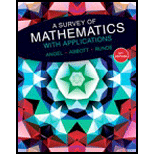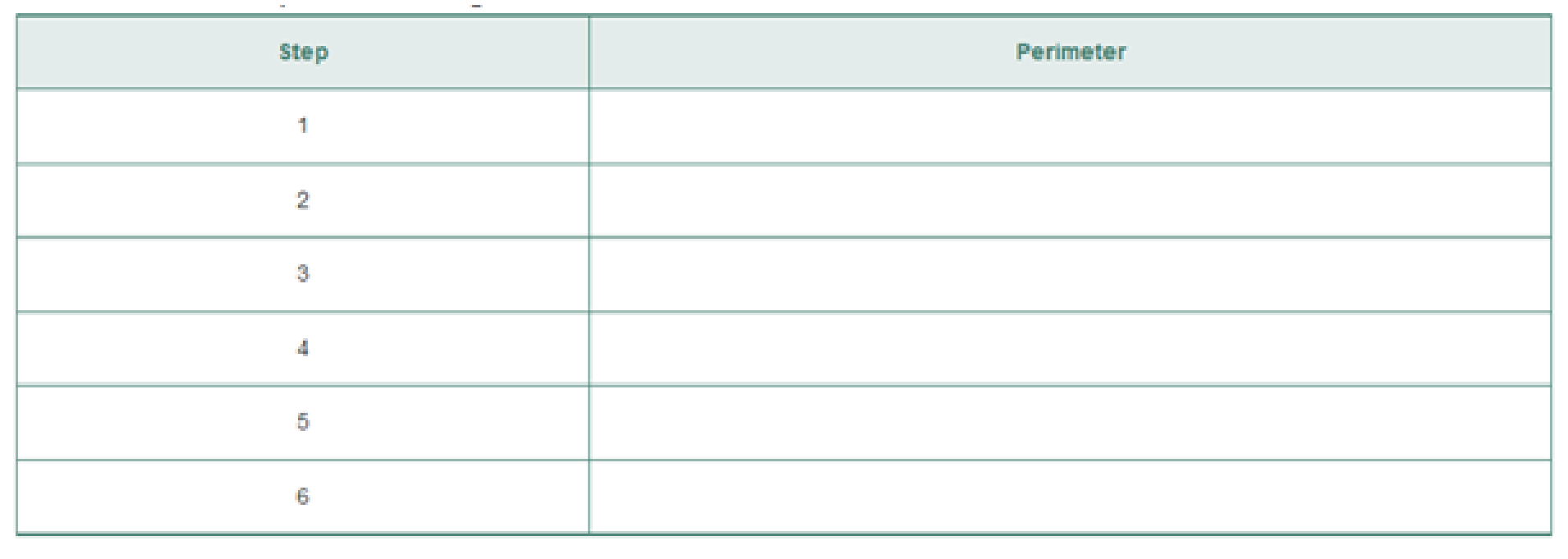
In forming the Koch snowflake in Figure 8.104 on page 510, the perimeter becomes greater at each step in the process. If each side of the original triangle is 1 unit, a general formula for the perimeter, L, of the snowflake at any step, n, may be found by the formula
For example, at the first step when n = 1, the perimeter is 3 units, which can be verified by the formula as follows:
At the second step, when n = 2, we find the perimeter as follows:
Thus, at the second step the perimeter of the snowflake is 4 units.
a. Use the formula to complete the following table.

b. Use the results of your calculations to explain why the perimeter of the Koch snowflake is infinite.
c. Explain how the Koch snowflake can have an infinite perimeter, but a finite area.
Want to see the full answer?
Check out a sample textbook solution
Chapter 8 Solutions
A Survey of Mathematics with Applications (10th Edition) - Standalone book
- No chatgpt pls will upvotearrow_forwardWhich degenerate conic is formed when a double cone is sliced through the apex by a plane parallel to the slant edge of the cone?arrow_forwardFor the problem below, what are the possible solutions for x? Select all that apply. 2 x²+8x +11 = 0 x2+8x+16 = (x+4)² = 5 1116arrow_forward
- For the problem below, what are the possible solutions for x? Select all that apply. x² + 12x - 62 = 0 x² + 12x + 36 = 62 + 36 (x+6)² = 98arrow_forwardSelect the polynomials below that can be solved using Completing the Square as written. 6m² +12m 8 = 0 Oh²-22x 7 x²+4x-10= 0 x² + 11x 11x 4 = 0arrow_forwardProve that the usual toplogy is firast countble or hot and second countble. ①let cofinte toplogy onx show that Sivast countble or hot and second firast. 3) let (x,d) be matricspace show that is first and second countble. 6 Show that Indiscret toplogy is firstand Second op countble or not.arrow_forward
- H.W For any events A and B, show that 1. P(AB)s P(A)≤ P(AUB)≤ P(A) + P(B)arrow_forwarda) Find the scalars p, q, r, s, k1, and k2. b) Is there a different linearly independent eigenvector associated to either k1 or k2? If yes,find it. If no, briefly explain.arrow_forwardPlz no chatgpt answer Plz Will upvotearrow_forward
- 1/ Solve the following: 1 x + X + cos(3X) -75 -1 2 2 (5+1) e 5² + 5 + 1 3 L -1 1 5² (5²+1) 1 5(5-5)arrow_forwardI need expert handwritten solution.to this integralarrow_forwardHow to understand and learn Laurent's serial and what's the point of Laurent's serial And what are the steps of a smooth solution for Laurentarrow_forward
- Algebra & Trigonometry with Analytic GeometryAlgebraISBN:9781133382119Author:SwokowskiPublisher:Cengage
 Mathematics For Machine TechnologyAdvanced MathISBN:9781337798310Author:Peterson, John.Publisher:Cengage Learning,
Mathematics For Machine TechnologyAdvanced MathISBN:9781337798310Author:Peterson, John.Publisher:Cengage Learning, Elementary Geometry For College Students, 7eGeometryISBN:9781337614085Author:Alexander, Daniel C.; Koeberlein, Geralyn M.Publisher:Cengage,
Elementary Geometry For College Students, 7eGeometryISBN:9781337614085Author:Alexander, Daniel C.; Koeberlein, Geralyn M.Publisher:Cengage,  College Algebra (MindTap Course List)AlgebraISBN:9781305652231Author:R. David Gustafson, Jeff HughesPublisher:Cengage Learning
College Algebra (MindTap Course List)AlgebraISBN:9781305652231Author:R. David Gustafson, Jeff HughesPublisher:Cengage Learning Algebra: Structure And Method, Book 1AlgebraISBN:9780395977224Author:Richard G. Brown, Mary P. Dolciani, Robert H. Sorgenfrey, William L. ColePublisher:McDougal Littell
Algebra: Structure And Method, Book 1AlgebraISBN:9780395977224Author:Richard G. Brown, Mary P. Dolciani, Robert H. Sorgenfrey, William L. ColePublisher:McDougal Littell Trigonometry (MindTap Course List)TrigonometryISBN:9781305652224Author:Charles P. McKeague, Mark D. TurnerPublisher:Cengage Learning
Trigonometry (MindTap Course List)TrigonometryISBN:9781305652224Author:Charles P. McKeague, Mark D. TurnerPublisher:Cengage Learning





